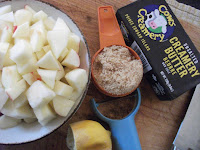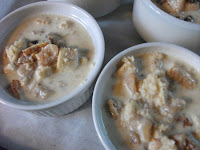I had some visitors this weekend, three of whom knew plenty about trees, flowers and such. Between them, I was able to confidently identify some trees and plants that I had previously only guessed at. I'm thrilled to find out that I have crab apple trees, two varieties.
I know they can be messy, and will likely attract wildlife for nibbles, but I'm excited to try crab apple butter again. The one time I tried making it I overcooked it, and rather than apple butter, it was more like fruit leather. It was tasty, but I didn't realize how thick it was, so instead of spreading it on sheets like regular fruit leather, I stored it in jars - kinda hard to dig out, so much of it was chucked uneaten. The flowering crab apple tree smells fabulous and is filled with bees today!
 |
| Hardy Geraniums - in pot and in garden |
During this long weekend in May, I also visited some plant sales. One woman in a neighbouring area was especially helpful, and I purchased a number of plants. After visits from friends, I realized that half the plants I purchased were already existing in my yard!
 |
| Lily of the Valley - in pot and in garden |
Ugh ... hopefully I'll get this whole flower thing worked out soon so I don't keep embarrassing myself like this. But it was worth the time I spent talking to the vendor, understanding which plants are good in shade, sun, etc. (and I saw the proof, as we walked around her yard where she pointed out each plant!).
 |
| Purchased two varieties |
I have been anxious about getting some daylilies as they are so pretty; I had even considered ordering some online. I could not believe how pricey they were! So when I found some locally this weekend, I grabbed what I could - $5 per plant (a steal, compared to online prices). Argghhh ... it turns out that I already have 3 patches; two of them very large. I had no idea what these were, I was thinking rhododendron, which is silly because I don't even know what rhododendrons look like (nothing like daylilies as it turns out).
 |
| One of three daylily patches in the yard |
 |
| Raspberry bush in the garden |
And since my recently planted raspberry canes are still strugging along, how great to be told that I already have several raspberry bushes! Odd location in the garden (at least, it seems odd to me) near the strawberries. I prefer them on the outskirts, so will see if a transplant is possible some other time. The raspberry canes I planted a few weeks back are not going to bear fruit anytime soon, so I'll take what I can get!

And lilacs - both lilac and white!
And a purple-leaf sandcherry (in need of pruning).

And a brief robin update ... not sure how many are left ... there are two in the nest that I can see, but I suspect one is the same I saw later in flight (and shown below on a ledge). I can't wait for them to be on their way so I can stop tip-toeing around the area!























































